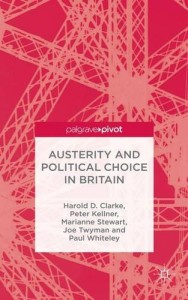Austerity and Political Choice in Britain
 Austerity and Political Choice in Britain comes with an all-star cast of authors – Harold D. Clarke, Peter Kellner, Marianne C. Stewart, Joe Twyman and Paul Whiteley – and, if you are familiar with their prior work, an expected thesis: that it is valence politics which dominates Britain at the moment. Or, as the authors put it, “voters choose political parties in elections on the basis of their demonstrated or expected ability to deliver the policies that large majorities of people want”.
Austerity and Political Choice in Britain comes with an all-star cast of authors – Harold D. Clarke, Peter Kellner, Marianne C. Stewart, Joe Twyman and Paul Whiteley – and, if you are familiar with their prior work, an expected thesis: that it is valence politics which dominates Britain at the moment. Or, as the authors put it, “voters choose political parties in elections on the basis of their demonstrated or expected ability to deliver the policies that large majorities of people want”.
Competency at delivering goals shared by the whole community (such as lower unemployment and better health services) is the prime force in British elections, they argue, rather than ideological choice between competing goals (such as privatising or nationalising services).
For the 2015 general election that primarily meant economic competency – both the battle over Labour’s record prior to 2010 and the record of the coalition government in 2010-15. Labour lost both those battles, and hence the election, the authors argue.
Most discussion about Labour’s economic reputation focuses in on its pre-2010 record (how responsible was it for what happened?) and how it talked about its record subsequently (should Labour have spent more time defending its record or apologising for it?).
Austerity and Political Choice in Britain hints at another explanation for Labour’s problems with economic reputation. It’s that during the 2010-15 Parliament, Labour’s rhetoric about the then current state of the economy was at odds with widespread public experience. Hence people’s economic optimism, both personal and for the country, started recovering in 2011 and from there on steadily improved all the way through the Parliament.
Falling unemployment figures resulted in regular Labour complaints that they somewhere weren’t real improvements, yet the public quietly got on with rising optimism in remarkable synch with the changes in the unemployment figures. More generally, people were at home thinking ‘things are getting a bit better now’ whilst hearing Labour politicians espousing doom and gloom. Although the authors don’t explore the consequences of this disjuncture between what Labour thought reality was and what most voters thought reality was, it is hard to avoid concluding that it further damaged Labour’s economic credibility.
Overall, the book sits between the two usual forms of British general election books. It does not have the sort of detailed insider stories specialised in by the likes of The British General Election of 2015, save for the tale of the candidate who wanted to hire an elephant. Nor does it have the sort of statistical detail of more technical studies such as the previous book from this team, Affluence, Austerity and Electoral Change in Britain. Here the statistical details are much lighter, making it more readable for the general audience though also it means that if you are not already sold on the valence explanation then you have to either take on trust or read up the footnoted references. The book itself explains the valence approach but does not have the detail of evidence within it to persuade doubters directly,
But that does make it more readable than a book full of detailed regression equations would be, and whilst such analysis is – outside of the footnotes – presented sparingly, it is used well, as when the authors show how little impact the the time and hassle of voting has on turnout. Factors such as a sense of civic duty, age and interest in the election have massively bigger impacts on turnout than the costs of voting. (Please note, voting innovation advocates.)
It also makes for a good top level introduction to many of the concepts political scientists use when analysing elections, such as ‘discounted benefits’ and of course ‘valence politics’.
At times that lack of further technical detail is frustrating – as with the passing reference to analysis which shows that contact from the Labour campaign was a major factor in increasing the chances of people voting Labour, but contact from other parties was not. That rather runs counter to the (persuasive) conventional wisdom about how good the Tory election campaign was, but is not explored in enough detail for the reader to be sure if it is really a substantive upending of what nearly everyone else is saying. (The fact that the authors do not make much of this finding suggests they don’t think it is either.)
The Palgrave Pivot series in which this book features (and for which I’m currently co-editing another title) specialises in much quicker turnaround than is the norm for academic texts. The speed with which Austerity and Political Choice in Britain appeared was certainly good on that score, though in this case I do wonder if a slightly slower production schedule would have resulted in more of those intriguing loose ends being followed up.
If you like this, you might also be interested in How voters decide who to vote for: Affluence, Austerity and Electoral Change in Britain.
Got a view on this review? Then please rate it on Amazon.
Leave a Reply